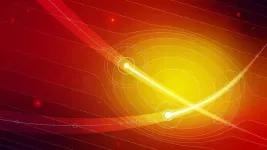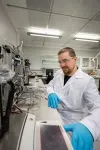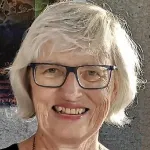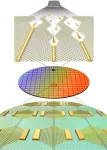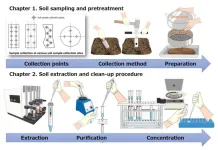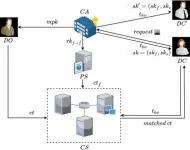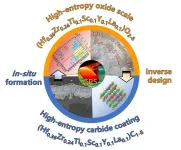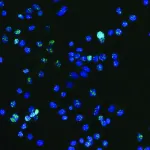(Press-News.org) In an ongoing game of cosmic hide and seek, scientists have a new tool that may give them an edge. Physicists at the U.S. Department of Energy’s (DOE) Princeton Plasma Physics Laboratory (PPPL) have developed a computer program incorporating machine learning that could help identify blobs of plasma in outer space known as plasmoids. In a novel twist, the program has been trained using simulated data.
The program will sift through reams of data gathered by spacecraft in the magnetosphere, the region of outer space strongly affected by Earth’s magnetic field, and flag telltale signs of the elusive blobs. Using this technique, scientists hope to learn more about the processes governing magnetic reconnection, a process that occurs in the magnetosphere and throughout the universe that can damage communications satellites and the electrical grid.
Scientists believe that machine learning could improve plasmoid-finding capability, aid the basic understanding of magnetic reconnection and allow researchers to better prepare for the aftermath of reconnection-caused disturbances.
“As far as we know, this is the first time that anyone has used artificial intelligence trained on simulated data to look for plasmoids,” said Kendra Bergstedt, a graduate student in the Princeton Program in Plasma Physics, which is based at PPPL. Bergstedt was the first author of the paper reporting the results in Earth and Space Science. The work pairs the Lab’s growing expertise in computational sciences with its long history of exploring magnetic reconnection.
Looking for a link
Scientists want to find reliable, accurate methods for detecting plasmoids so they can determine whether they affect magnetic reconnection, a process consisting of magnetic field lines separating, violently reattaching and releasing tremendous amounts of energy. When it occurs near Earth, reconnection can trigger a cascade of charged particles falling into the atmosphere, disrupting satellites, mobile phones and the electrical grid. “Some researchers believe that plasmoids aid fast reconnection in large plasmas,” said Hantao Ji, professor of astrophysical sciences at Princeton University and a distinguished research fellow at PPPL. “But those hypotheses haven’t been proven yet.”
The researchers want to know whether plasmoids can change the rate at which reconnection occurs. They also want to gauge how much energy reconnection imparts to the plasma particles. “But to clarify the relationship between plasmoids and reconnection, we have to know where the plasmoids are,” Bergstedt said. “That’s what machine learning could help us do.”
The scientists used computer-generated training data to ensure the program could recognize a range of plasma signatures. Typically, plasmoids created by computer models are idealized versions based on mathematical formulas with shapes — like perfect circles — that do not often occur in nature. If the program were trained only to recognize these perfect versions, it might miss those with other shapes. To prevent those misses, Bergstedt and Ji decided to use artificial, deliberately imperfect data so the program would have an accurate baseline for future studies. “Compared to mathematical models, the real world is messy,” Bergstedt said. “So we decided to let our program learn using data with fluctuations that you would get in actual observations. For instance, rather than beginning our simulations with a perfectly flat electrical current sheet, we give our sheet some wobbles. We’re hoping that the machine learning approach can allow for more nuance than a strict mathematical model can.” This research builds on past attempts in which Bergstedt and Ji wrote computer programs that incorporated more idealized models of plasmoids.
The use of machine learning will only become more common in astrophysics research, according to the scientists. “It could particularly be helpful when making extrapolations from small numbers of measurements, as we sometimes do when studying reconnection,” said Ji. “And the best way to learn how to use a new tool is to actually use it. We don’t want to stand on the sidelines and miss an opportunity.”
Bergstedt and Ji plan to use the plasmoid-detecting program to examine data being gathered by NASA’s Magnetospheric Multiscale (MMS) mission. Launched in 2015 to study reconnection, MMS consists of four spacecraft flying in formation through plasma in the magnetotail, the area in space pointing away from the sun that is controlled by Earth’s magnetic field.
The magnetotail is an ideal place to study reconnection because it combines accessibility with scale. “If we study reconnection by observing the sun, we can only take measurements from afar,” Bergstedt said. “If we observe reconnection in a laboratory, we can put our instruments directly into the plasma, but the sizes of the plasmas would be smaller than those typically found in space.” Studying reconnection in the magnetotail is an ideal middle option. “It’s a large and naturally occurring plasma that we can measure directly using spacecraft that fly through it,” Bergstedt said.
As Bergstedt and Ji improve the plasmoid-detecting program, they hope to take two significant steps. The first is performing a procedure known as domain adaptation, which will help the program analyze datasets that it has never encountered before. The second step involves using the program to analyze data from the MMS spacecraft. “The methodology we demonstrated is mostly a proof of concept since we haven’t aggressively optimized it,” Bergstedt said. “We want to get the model working even better than it is now, start applying it to real data and then we’ll just go from there!”
This research was supported by the DOE’s Fusion Energy Sciences program under contract DE-AC0209CH11466, by NASA under grants NNH15AB29I and 80HQTR21T0105, and by the National Science Foundation Graduate Research Fellowship under grant DGE-2039656.
--
PPPL is mastering the art of using plasma — the fourth state of matter — to solve some of the world's toughest science and technology challenges. Nestled on Princeton University’s Forrestal Campus in Plainsboro, New Jersey, our research ignites innovation in a range of applications, including fusion energy, nanoscale fabrication, quantum materials and devices, and sustainability science. The University manages the Laboratory for the U.S. Department of Energy’s Office of Science, which is the nation’s single largest supporter of basic research in the physical sciences. Feel the heat at https://energy.gov/science and http://www.pppl.gov.
END
Machine learning could aid efforts to answer long-standing astrophysical questions
2024-07-03
ELSE PRESS RELEASES FROM THIS DATE:
Research spotlight: Uncovering how a cellular miscommunication leads to cognitive impairment in female patients with Alzheimer’s disease
2024-07-03
Lead author Neta Rosenzweig, PhD, of the Ann Romney Center for Neurological Diseases, and senior author Oleg Butovsky, PhD, of the Ann Romney Center and Gene Lay Institute of Immunology and Inflammation, share key messages from their paper “Sex-Dependent APOE4 Neutrophil-Microglia Interactions Drive Cognitive Impairment in Alzheimer’s Disease” published in Nature Medicine.
How would you summarize your study for a lay audience?
In this manuscript, we identify that a major genetic risk ...
AI model to improve patient response to cancer therapy
2024-07-03
A new artificial intelligence (AI) tool that can help to select the most suitable treatment for cancer patients has been developed by researchers at The Australian National University (ANU).
DeepPT, developed in collaboration with scientists at the National Cancer Institute in America and pharmaceutical company Pangea Biomed, works by predicting a patient’s messenger RNA (mRNA) profile. This mRNA - essential for protein production - is also the key molecular information for personalised cancer medicine.
According to lead author Dr Danh-Tai Hoang from ANU, when combined with a second tool called ENLIGHT, DeepPT ...
Scientists discover way to “grow” sub-nanometer sized transistors
2024-07-03
A research team led by Director JO Moon-Ho of the Center for Van der Waals Quantum Solids within the Institute for Basic Science (IBS) has implemented a novel method to achieve epitaxial growth of 1D metallic materials with a width of less than 1 nm. The group applied this process to develop a new structure for 2D semiconductor logic circuits. Notably, they used the 1D metals as a gate electrode of the ultra-miniaturized transistor.
Integrated devices based on two-dimensional (2D) semiconductors, which exhibit excellent properties even at the ultimate limit of material thickness down to the atomic ...
Bath student wins national award for computer game that explores mental health
2024-07-03
A final year computer science undergraduate from the University of Bath has been named amongst the UK’s best student game developers, having won an award in the “Games with purpose” category at the Games Innovation Challenge 2024.
Salmaan Zhang competed against university and college students from across the country to win one of seven categories in the competition, which is sponsored by UNiDAYS and delivered by NSE (National Student Esports).
The challenge asked students in the UK to create the most innovative game in just eight weeks. Submitted entries were shortlisted and then judged by industry experts in several ...
NARO developed a novel method to analyze “forever chemicals” in the soil
2024-07-03
Concern about the effects of PFAS are of increasing globally. Also there is no accurate method for analyzing multiple PFAS in soil. Hence, a team of PFAS researchers led by NARO et.al sought to develop a stable and accurate method for analyzing multicomponent PFAS in the soil (Ministry of Agriculture, Forestry and Fisheries -MAFF project).
Unlike the PFAS analysis method for water samples, it is difficult to ensure the extraction efficiency of the target PFAS in diverse soil samples. In Japan, there are 381 soil types, with volcanic ash soils being the predominant. Since these soils possess high carbon content, ...
Scientists pinpoint strategies that could stop cats from scratching your furniture
2024-07-03
Many cat owners are familiar with torn cushions, carpets, and couches. The feline instinct to scratch is innate but is often perceived as a behavioral problem by cat owners and sometimes leads to interventions that are not cat friendly.
Now, an international team of researchers has investigated which factors influence undesired scratching behavior in domestic cats. They published their findings in Frontiers in Veterinary Science.
“Here we show that certain factors – such as the presence of children at home, personality traits of cats, and their activity levels – significantly impact the ...
Offline/online attribute-based searchable encryption scheme from ideal lattices
2024-07-03
The security of traditional attribute-based searchable encryption schemes relies on traditional number-theoretic assumptions, and thus they are not able to resist the threat of quantum algorithms. Meanwhile, existing lattice-based searchable encryption schemes have two main problems: one is the low efficiency of the execution of encryption, key generation and search algorithms. The second is the large space required for storing search trapdoors.
To solve the problems, a research team led by Yang YANG published their new ...
Theoretical design and experimental verification of high-entropy carbide ablative resistant coating
2024-07-03
The hot-end components of high-performance high-speed aircrafts need to meet performance requirements such as long service life, wide temperature range oxidation resistance and ablation resistance. This puts forward higher requirements for high-temperature service performance of thermal protection system (TPS).
With low density, low expansion and excellent high temperature mechanical properties, carbon-carbon (C/C) composites are expected to be the best choice for the new generation of TPS. However, the oxidation sensitivity of C/C composites severely limits their service life in high-temperature ablation environment. It ...
Cultural adaptation of behavioral interventions in health promises more effective results for the population
2024-07-03
Behavioral interventions are strategies designed to help people change their behaviors in a way that is positive for themselves and the community. These behaviors can relate to various topics, such as health, citizenship, ecology, and more. Interventions can be applied individually, like someone seeing a psychologist to quit smoking, or collectively, such as NGOs and public institutions investing in anti-smoking campaigns or raising awareness about the dangers of drunk driving.
Understanding how to adapt behavioral interventions to different cultures is essential for the success of health ...
New class of cancer mutations discovered in so-called ‘junk’ DNA
2024-07-03
New class of cancer mutations discovered in so-called ‘junk’ DNA
Using artificial intelligence, Garvan Institute researchers have found potential cancer drivers hidden in so-called ‘junk’ regions of DNA, opening up possibilities for a new approach to diagnosis and treatment.
Non-coding DNA – the 98% of our genome that doesn’t contain instructions for making proteins – could hold the key to a new approach for diagnosing and treating cancers, according to a new study from the Garvan Institute of Medical Research. The findings, ...
